Some of the most common birds of the world that aren’t easy to spot have yellow eyes.
Multiple species of owls have yellow eyes. Their nocturnal hunting habits and secretive lives make them difficult to spot.
While some types of birds with yellow eyes are easy to spot since they can live in urban areas, many live outside urban areas in savannahs, mixed woodlands, coniferous woodlands, coastal areas, or on remote islands of the world.
Eagles also come with yellow eyes across multiple species. These birds are also difficult to spot, especially since many only look for prey in rivers or open seas.
Some species of ducks also have yellow eyes of different nuances. Diving ducks that are ready to go deep into the water for fish often come with yellow eyes either throughout the year or in the breeding period.
Yellow eyes don’t prove a bird species has better vision. It can be an adaptation but many species only truly have yellow eyes once they reach adulthood.
Bird iris colors can change over time. Juveniles are rarely born with bright eyes and only get yellow irises once they’re ready to move out on their own.
The following species of birds are known for having different shades of yellow eyes and may even be spotted in different regions around the world.
Table of Contents
1. Hooded Merganser
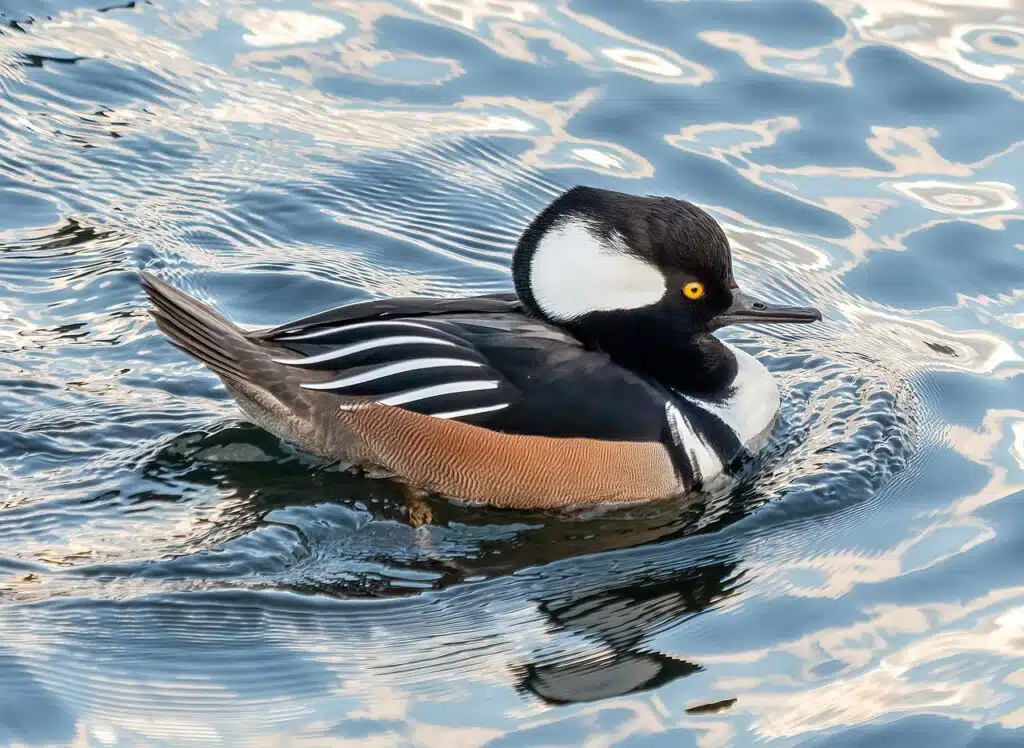
Hooded Mergansers (Lophodytes cucullatus) are common North American ducks with yellow eyes.
There’s a clear difference to which Hooded Mergansers have yellow eyes as only males have them.
The young male duck initially has pale eyes which become yellow as it reaches its breeding age. Females have dark brown eyes and even have different plumage.
Yellow nuances are only seen in the eyes of males and not in their plumage. In turn, females have a yellow beak while males have a black beak.
Males also turn black and white on the back and wings going into the breeding season.
Distribution – Western Canada, Southern Canada, Eastern United States, Western United States
2. Great-tailed Grackle
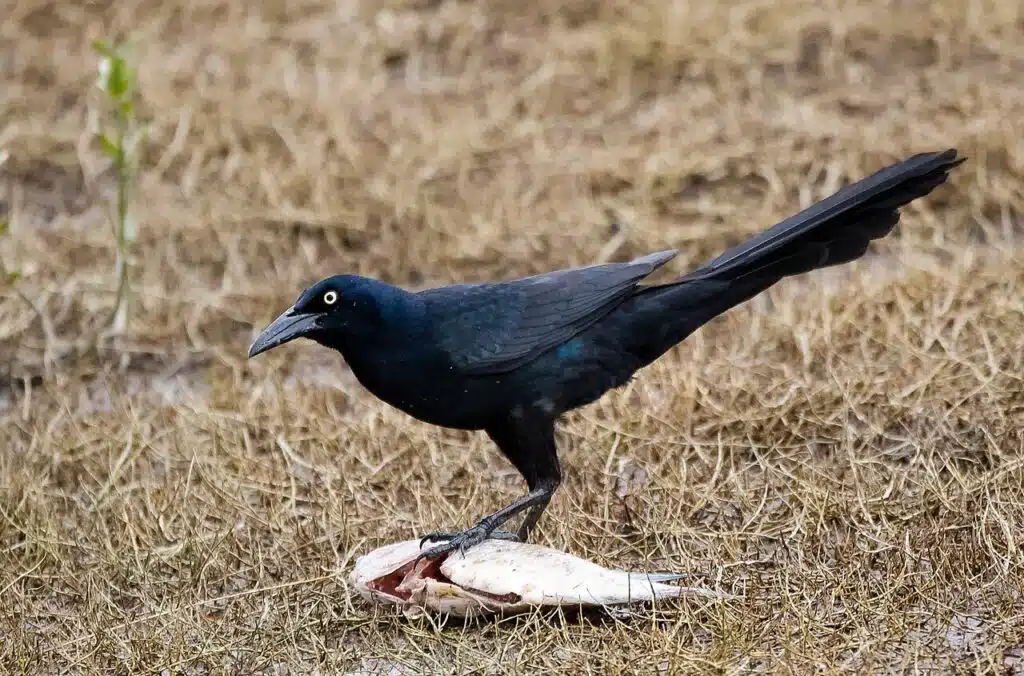
Yellow eyes are the only bright section on the dark-looking Great-tailed Grackle (Quiscalus mexicanus).
Birds of the species are sexually dimorphic, with considerable differences between males and females.
While both males and females have yellow eyes, males have a black color with blue-purple metallic undertones.
Some areas such as the head are black and purple while its wings and belly are black with blue nuances.
Females are mostly brown. They show various shades of brown but also have yellow eyes.
Juveniles of the species don’t have yellow eyes.
Distribution – Central and Southern United States, Mexico, Guatemala, Costa Rica, Panama, Venezuela, Ecuador
3. Ring-necked Duck
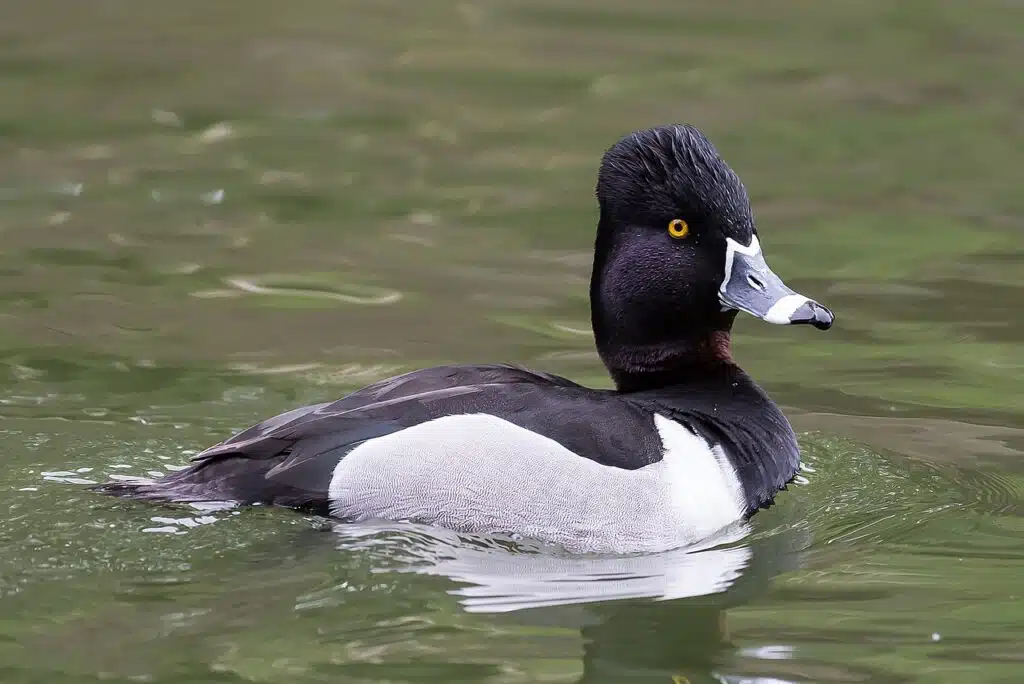
Much of the Ring-necked Duck’s (Aythya collaris) appearance changes going into the breeding season.
Males are the ones with the yellow eyes, but only in the breeding period. Their eyes are orange-yellow before brightening up to vivid yellow in the breeding period.
Females have dark brown eyes but have different traits such as the capacity to make noises.
Males aren’t named after their bright eyes but after the cinnamon-brown neckband spotted in the breeding season.
A black neck base color means this neckband might not be easily spotted.
Distribution – Northern Canada, Eastern Canada, Central Canada, United States, Mexico, Cuba, Panama
4. Lesser Scaup
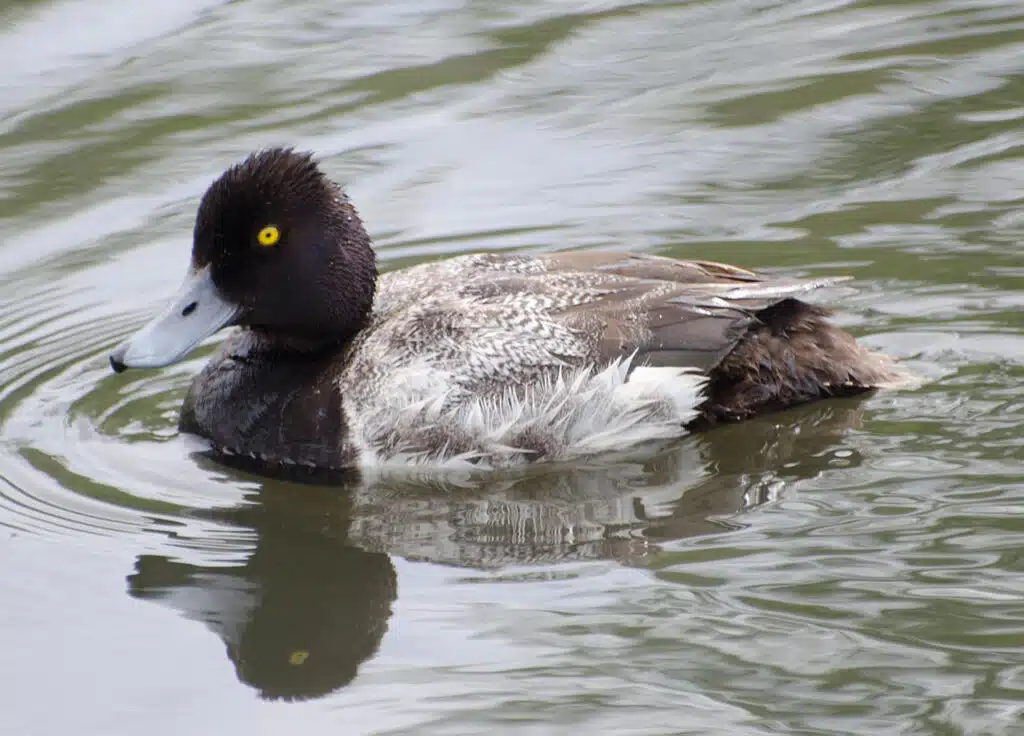
A migratory species of diving ducks in North America, Lesser Scaups (Aythya affinis) are differentiated by their appearance when it comes to males and females.
The male has bright yellow eyes while female ducks have bright brown eyes.
Males are also brighter while females are dominated by brown plumage.
Lesser Scaups are also known for their bright blue bills only seen on males. This is what inspires their name Little Bluebills, despite reaching sizes of up to 19 inches.
These diving ducks live in some of the coolest areas of North America, including Alaska. They migrate to California or The Gulf of Mexico to overwinter.
Distribution – United States, Canada, Mexico
5. Common Goldeneye
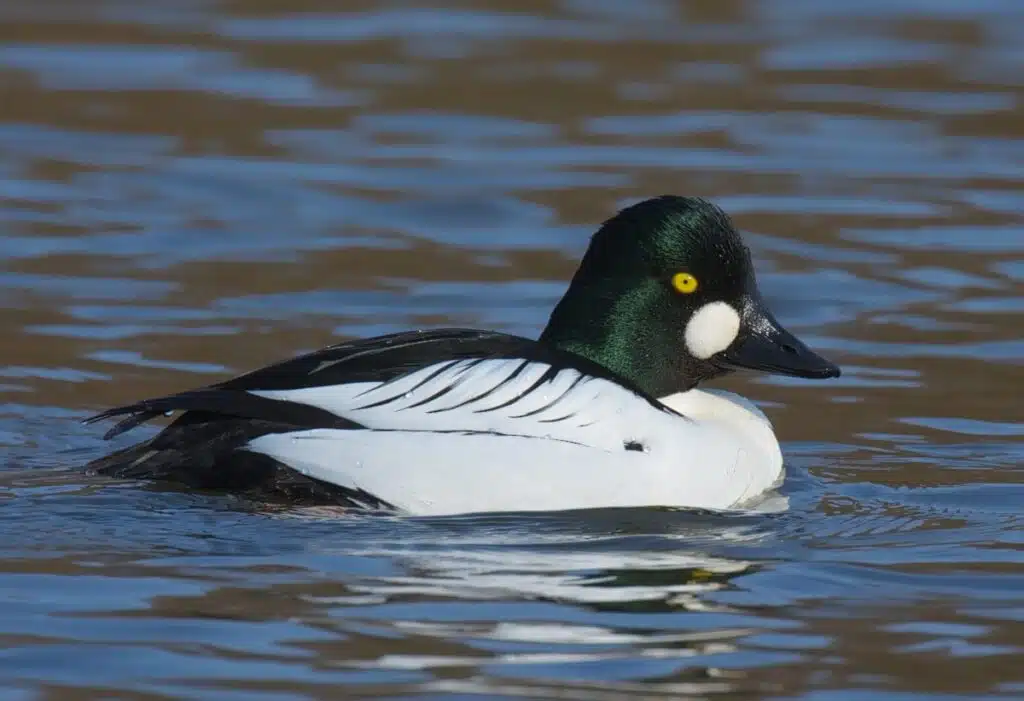
Golden yellow eyes inspire the name of these ducks (Bucephala clangula).
Both males and females show bright yellow eyes which are contrasted by a dark head but which has different colors from males to females.
Male Common Goldeneyes have a dark head with a dark green sheen. This dark head is in stark contrast with their yellow eyes and white patches on the face.
Yellow-eyed females have a brown head but they have a yellow-orange feed.
Plumage differences are further seen between the sexes. Males are black and white while females are mostly gray and white.
Boreal forests are the ideal habitats for these otherwise aggressive ducks,
Distribution – Canada, United States, Russia, China
6. Cattle Egret
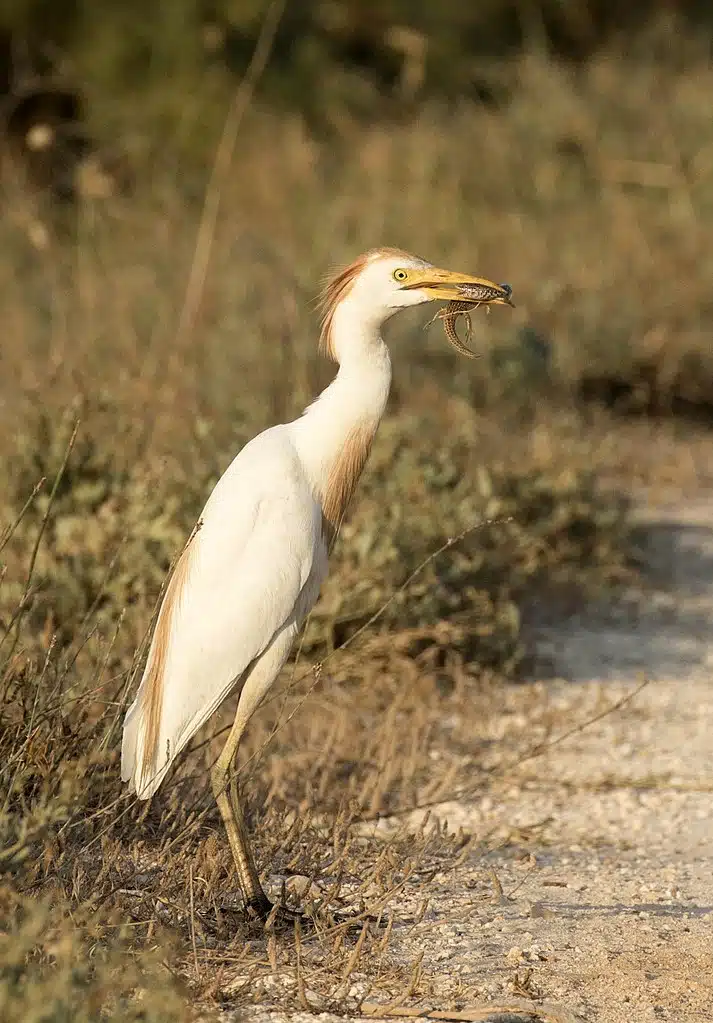
A species of the tropics and subtropics, Cattle Egrets (Bubulcus ibis) are named after they tend to rest on cattle.
These types of birds change their appearance going into the breeding season.
Yellow eyes are specific to the species. The yellow nuance becomes orange or orange-red in the breeding season.
Its plumage also changes from white to white and orange as the breeding period begins soon after these birds return from their overwintering sights (in the case of migrating populations).
These types of birds are found on all continents. They show a year-round presence in South America, Africa, and Southern Asia.
Distribution – North America, Central America, South America, Western Europe, Africa, Southeast Asia, Australia
7. Redhead
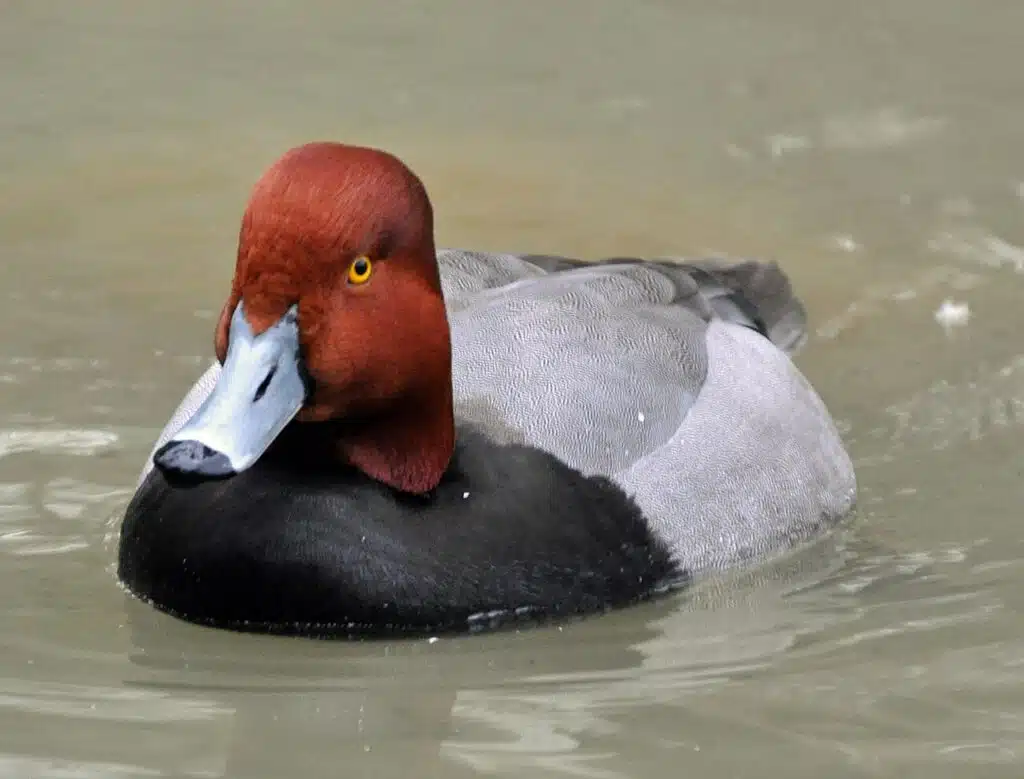
A North American Species, Redheads (Aythya americana) are named after the vivid color of the male ducks.
These ducks have blue bills and brown plumages. Males also have brown eyes.
Females, on the other hand, have vivid yellow eyes. They have gray and white plumage and also show a bright blue bill color.
The presence of the species in The Americas is complex. It lives in Canada and Alaska before migrating to Southern US states or Central America.
Resident populations are found in Washington state and Oregon but also in other central and Eastern US states.
It’s estimated there are more than 1 million Redheads in North America.
Distribution – Canada, United States, Mexico, Cuba
8. Egyptian Goose
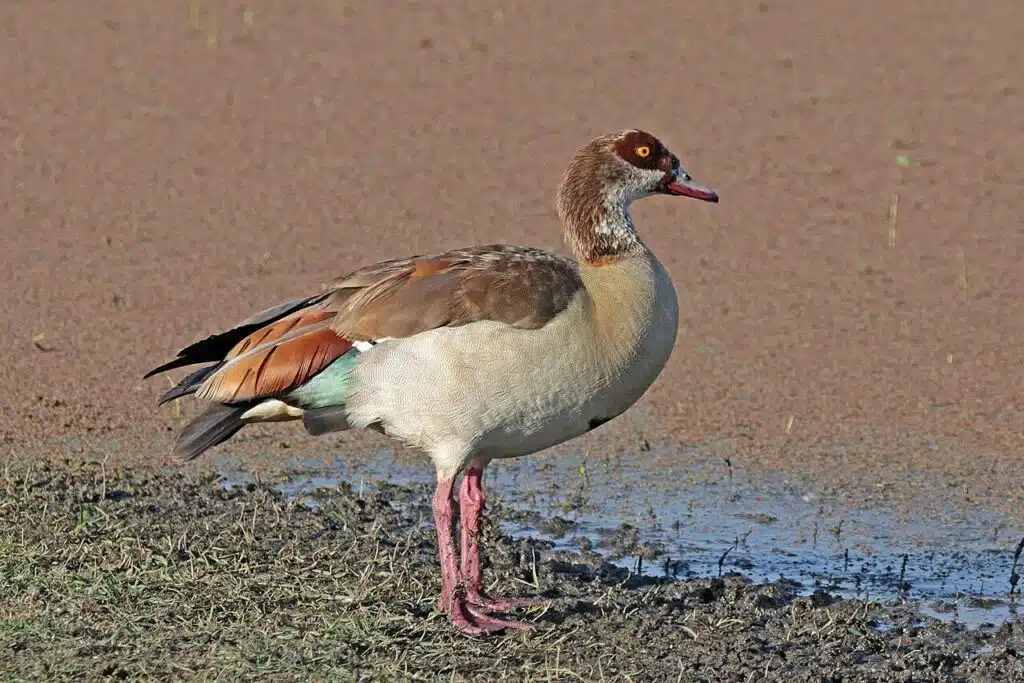
Reaching a size of at least 25 inches, Egyptian Gooses (Alopochen aegyptiaca) are large birds with yellow eyes.
These types of geese play an important role in the popular culture and beliefs of Ancient Egypt and are known around the world.
They show yellow eye coloring before their breeding season. The nuance of the eyes darkens to orange going into the breeding period.
Widespread around Egypt and much of Africa, the species also has eyes that stand out as there are brown round patches around them on their bright heads.
Egyptian Geese’s eye colors change with time. Initially black on juveniles, the eyes brighten as the species matures.
In the breeding season, these geese show bright red beaks and even green plumage, particularly in males.
Distribution – Africa
9. Brewer’s Blackbird
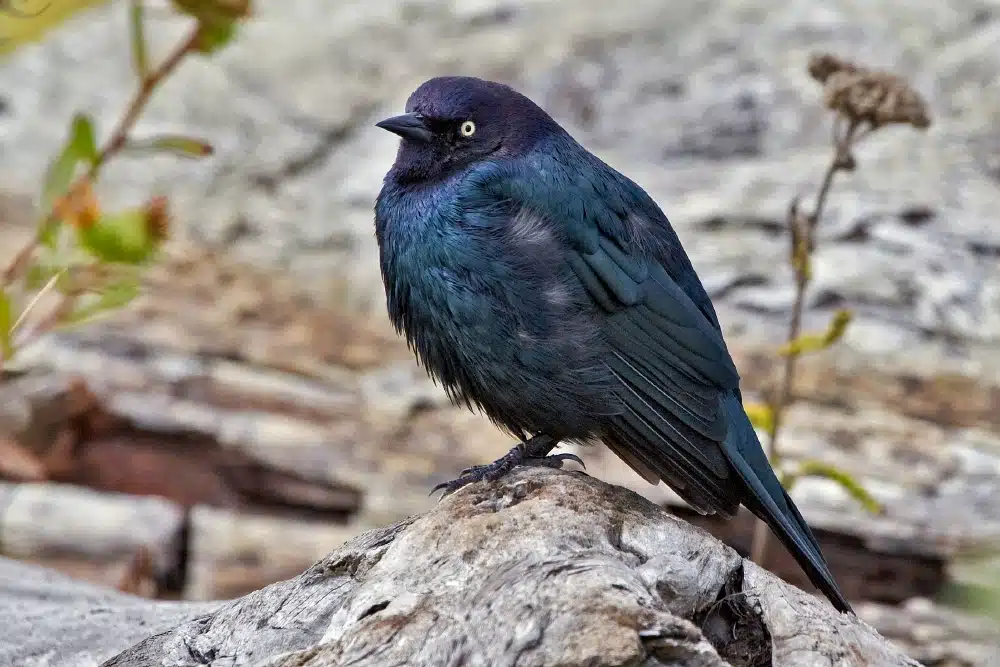
Bright yellow eyes are characteristic of male Brewer’s Blackbirds (Euphagus cyanocephalus). Females have brown eyes while juveniles have brown-black eyes.
The eyes of males are highlighted by their black plumage. The black plumage of males has blue or purple tints.
The heads of males are particularly purple while the wings and underbellies are black with dark blue hues in direct sunlight.
Females are dominated by brown and tan nuances but show black wings and black tails.
Distribution – Northern, Western, and Southern United States, Mexico
10. Greater Scaup
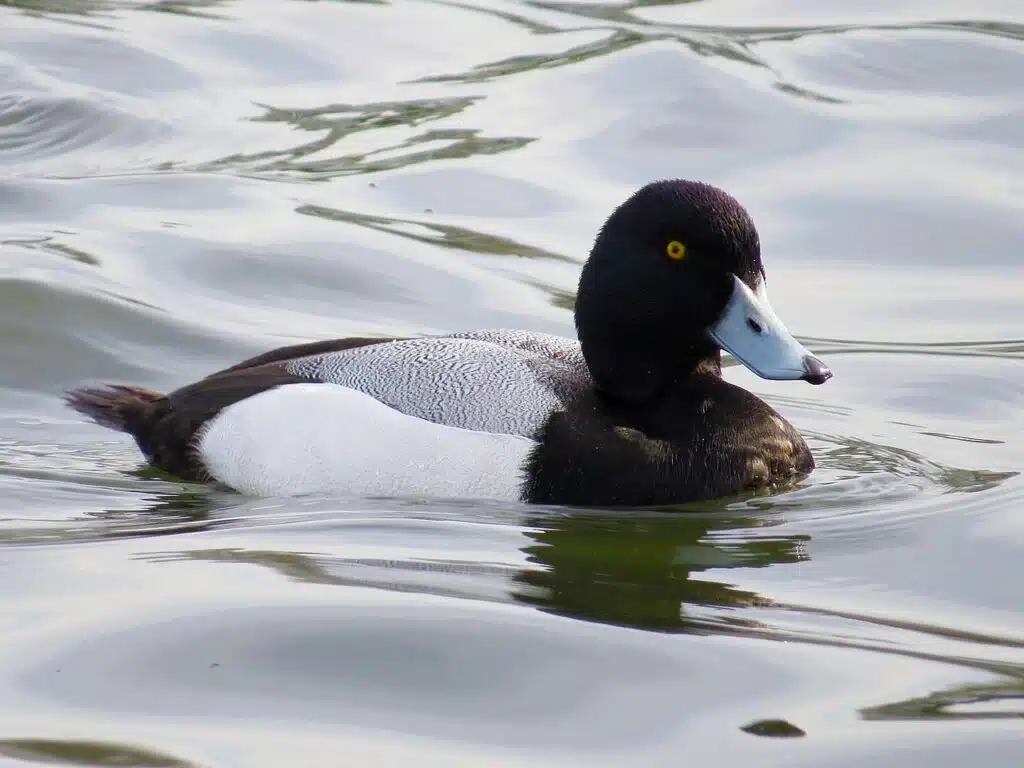
A species of widespread diving ducks, Greater Scaups (Aythya marila) show yellow eye coloring both on males and females.
These types of ducks have dark yellow eyes but males and females have different plumage.
Male Greater Scaups have dark green heads as well as white, gray, and black plumage.
Females have black heads and right blue bills. Their underbellies are brown, as opposed to the white alternative seen in males.
Darker wings are also specific to females as opposed to males.
Aquatic plants are among the most common foods of these ducks that can dive.
Distribution – North America, Northern Europe, East and North Asia
11. Burrowing Owl
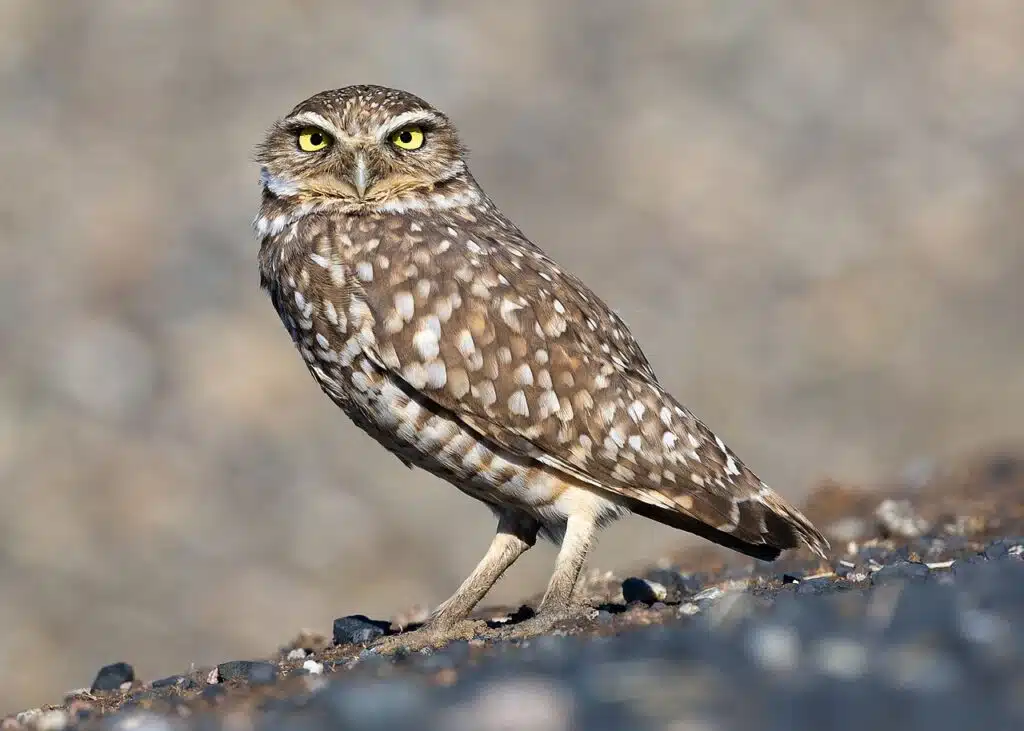
Yellow eyes are specific to male Burrowing Owls (Athene cunicularia). Females have brown eyes and spend more time hiding in burrows.
Immature males also show vivid yellow eyes as well as a generally brighter appearance as opposed to females.
A species not seen during the day as it prefers early morning and late evening activities, Burrowing Owls may repurpose the burrows of other species.
It looks for burrows large enough for them which are often those of prairie dogs or those of squirrels.
Since it spends much of its time on the ground, this species is very good at walking fast as well as flying.
Distribution – America
12. Common Grackle
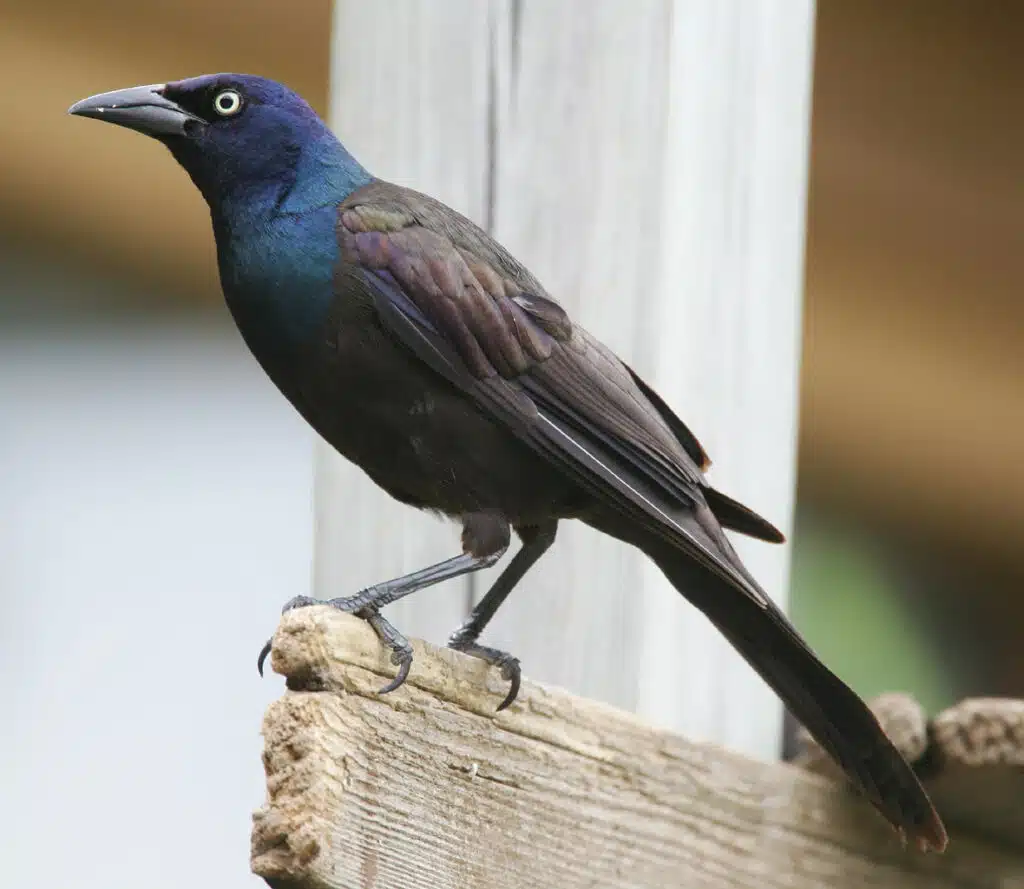
Shrubs and vegetation in shallow water in The Eastern parts of North America are the main habitats of The Common Grackle (Quiscalus quiscula).
This species has vivid yellow eyes which are highly visible given the grackle has a dark, almost black appearance.
Its head is iridescent dark blue with a few blue-purple sections.
Its wings and underbelly are black
Females of the species are partially brighter, with brown wings and underbellies but they also show bright yellow eyes.
Found in shrubs and trees, The Common Grackle makes its nests where it lays up to 7 eggs.
Distribution – Eastern United States, Southeastern Canada
13. Bendire’s Thrasher
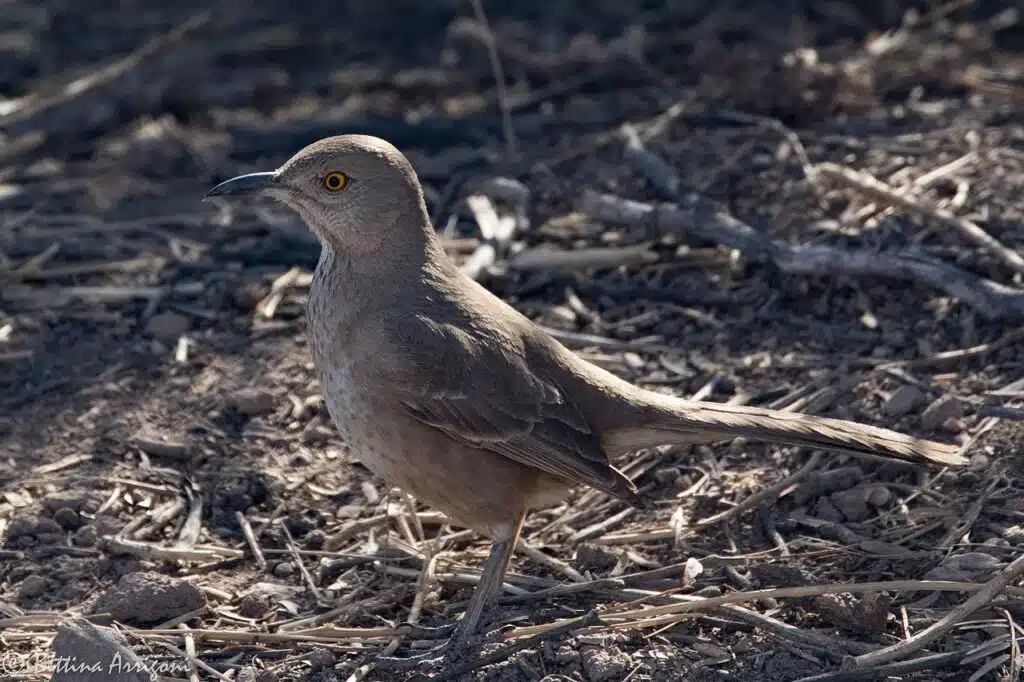
Reaching a maximum size of 11 inches, Bendire’s Thrashers (Toxostoma bendirei) are named after the ornithologist that first described them as a separate species of the Southwestern United States.
Mostly gray plumage and bright yellow eyes are seen on males and females.
The wings have a slightly darker gray nuance while the underbelly has a tan nuance.
Small gray marks in the shape of a triangle may also be identified on its underbelly. Bendire’s Thrashers also have long gray tails.
This is a species with a slightly curbed dark bill which makes it easier to distinguish from other gray species.
Distribution – California, Nevada, Arizona, Texas
14. American Oystercatcher
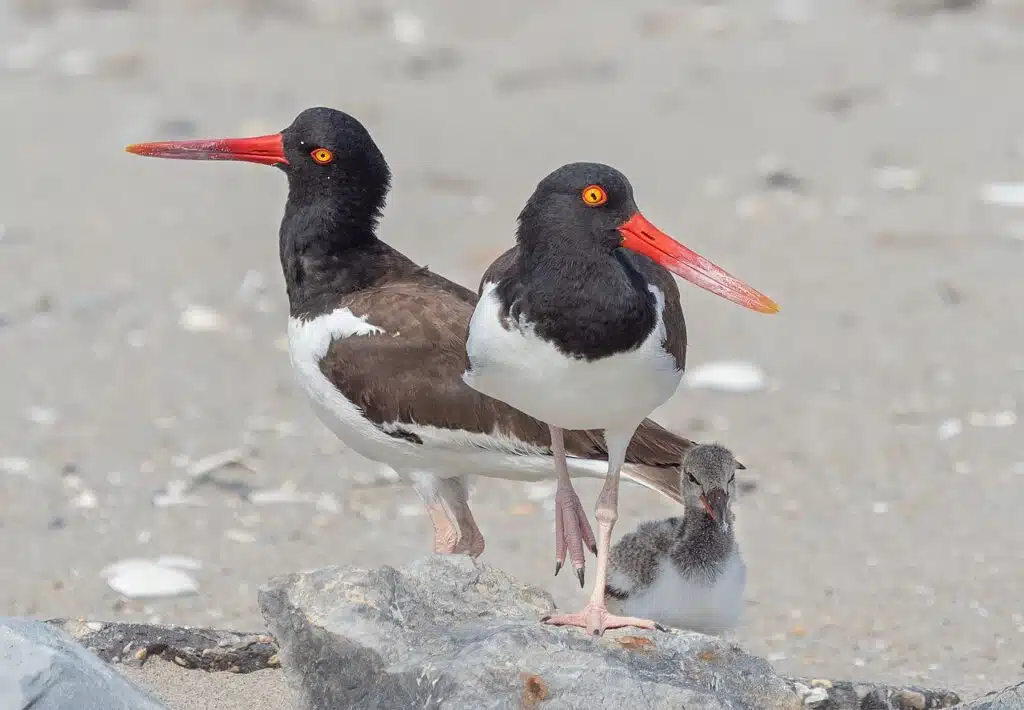
Vivid yellow eyes with red skin patches around them are specific to American Oystercatchers (Haematopus palliatus).
These types of birds have long red beaks and black heads.
Distinguishable physical traits also include white underbellies and brown wings.
The yellow eyes are only specific to the adult American Oystercatcher as juveniles have dark eyes and mostly gray and white plumage.
A species found on beaches, American Oystercatchers are seen in multiple areas along the East Coast and The Gulf of Mexico.
These colorful birds also migrate to Central and South America to overwinter where they also feed on shellfish.
Distribution – US East Coast, The Gulf of Mexico, Eastern, and Western South American Coasts
15. Snowy Owl
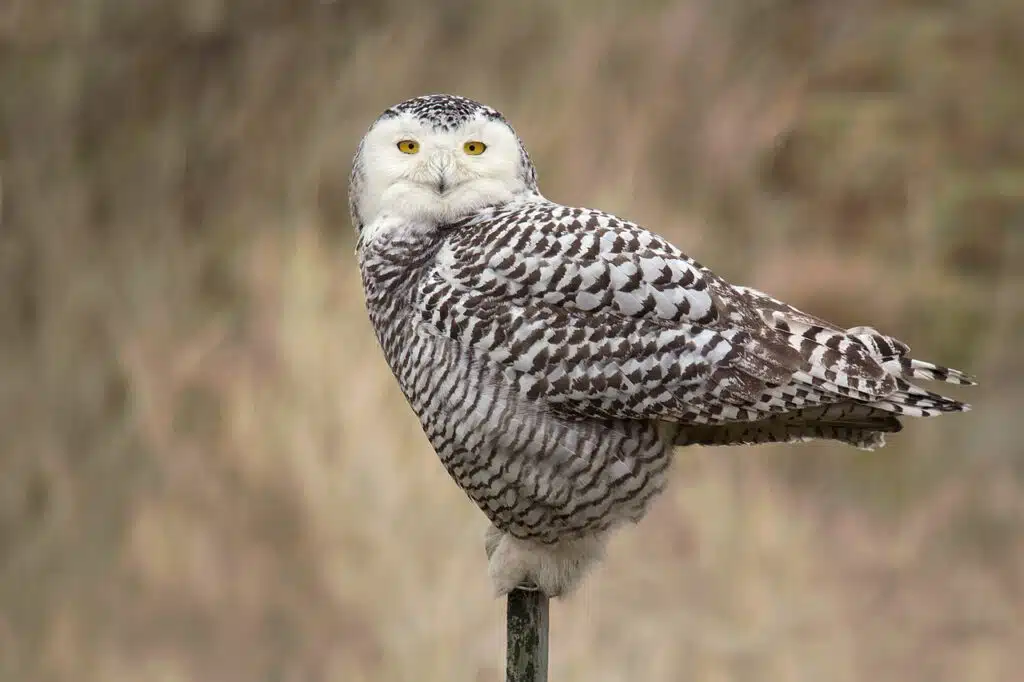
Snowy Owls (Bubo scandiacus) are the only types of owls to be mostly white, as a result of their Northern Arctic habitats.
These types of owls also have bright yellow eyes, a characteristic which has some exceptions such as hybrids with orange eyes.
These types of predators have white and black plumage and are found across North America, Northern Europe, and Northern Asia.
A short breeding season means these birds might even migrate soon to breed. They tend to seek out new breeding locations as Snowy Owls aren’t tied to their native areas for breeding.
Snowy Owls are well-adapted to hunting in the long Arctic nights.
Distribution – Canada, Alaska, Greenland, Scandinavia, Northern Russia
16. Barrow’s Goldeneye
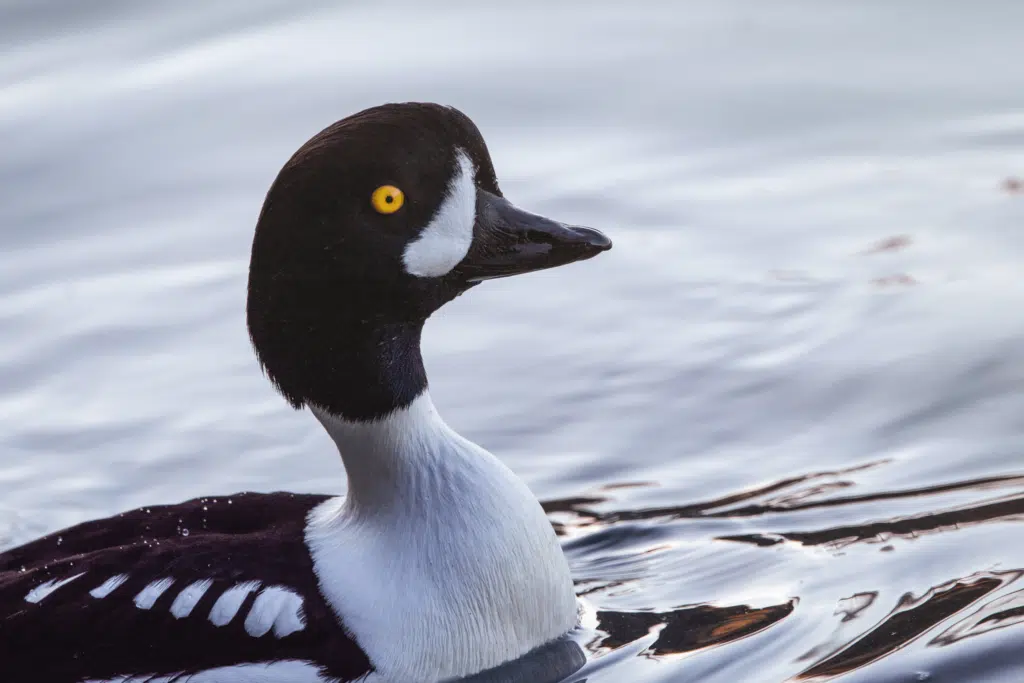
A color change occurs in the eyes of male and female Barrow’s Goldeneyes (Bucephala islandica) entering the breeding season.
Males have white eyes or pale yellow eyes and slowly turn to yellow eyes, together with the females.
The dark or golden nuance of the eyes is contrasted by a black head on males and a dark brown head on females.
Further differences are seen between the sexes. Males show a black beak while females have an orange beak.
Males also have black and white plumage but they can also have a metallic green iridescent head nuance.
Unlike females, males may also show large white marks on the face.
Distribution – Western Canada, Northwestern United States
17. Western Screech-Owl
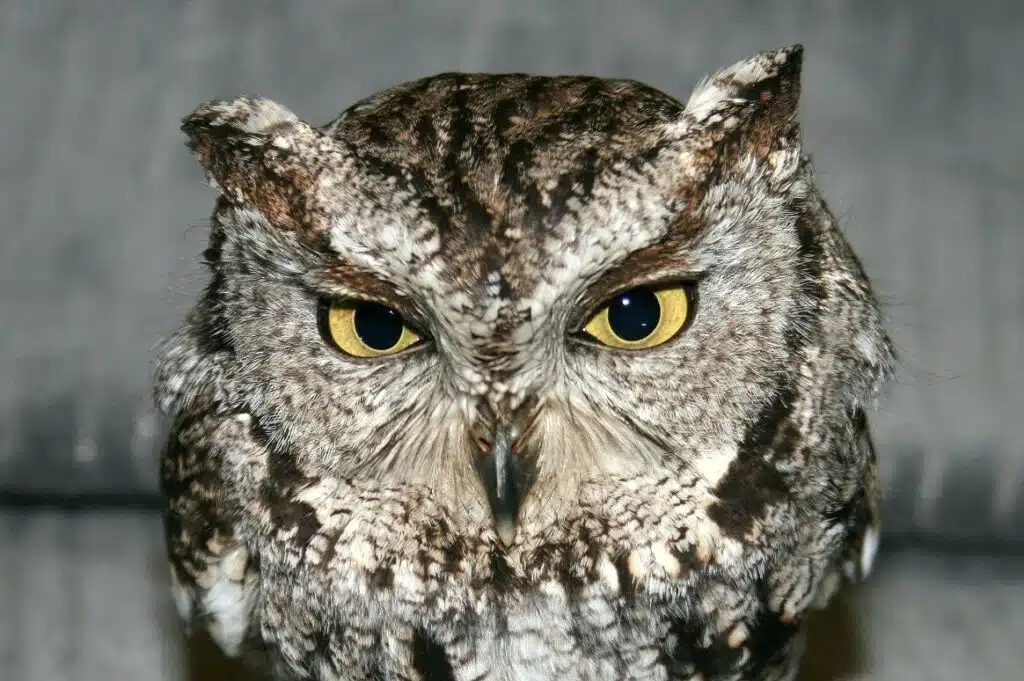
Large yellow eyes are specific to The Western Screech-Owl (Megascops kennicottii).
This species is named after its habitat which is limited to territories West of The Rocky Mountains in The United States.
Much of the plumage of these types of owls is influenced by the trees and shrubs the species lives on.
Western Screech-Owls prefer not to build their nests in favor of seeking out natural cavities to nest in.
Hardwood trees are often their nests. In some cases, these natural cavities may also serve as nests for other bird species.
Owls of this genus come out at night for food such as rodents.
Distribution – Western United States, Western Canada, Baja California, Western Mexico
18. Red-crowned Parrot
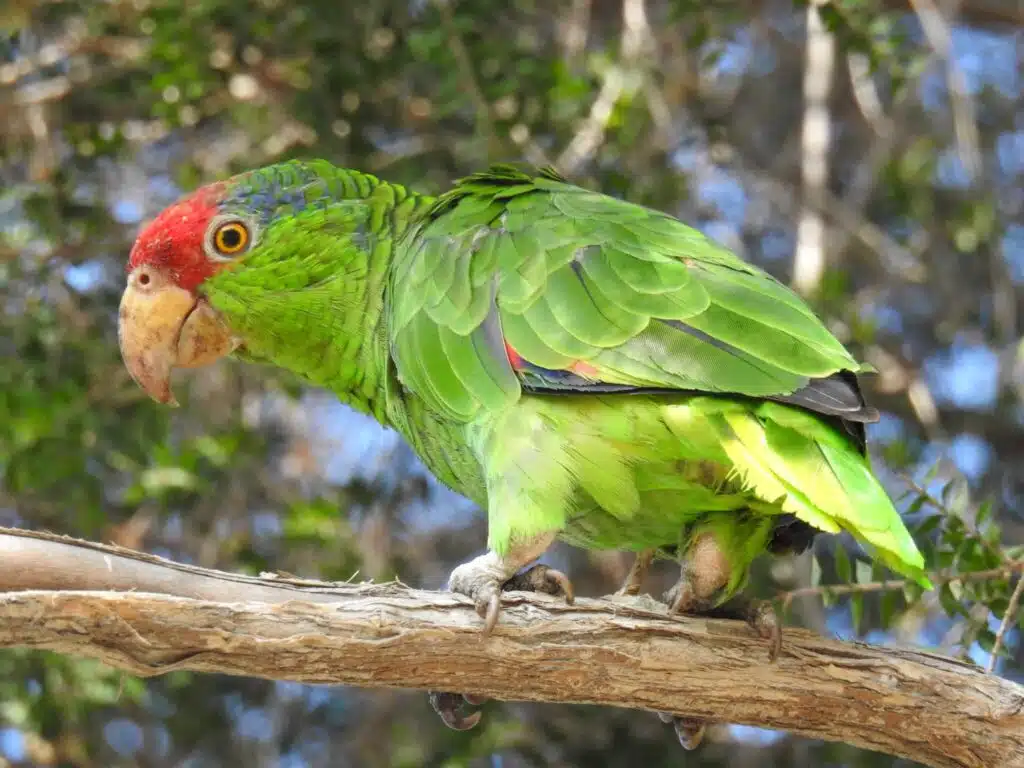
Yellow eyes are specific to Red-crowned Parrots (Amazona viridigenalis). This is a species of parrot with the variable color of the eyes, according to seasons and the age of the bird.
Most months, Red-crowned Parrots have yellow eyes. Their irises then turn red or orange-red in the breeding season.
Juvenile Red-crowned Parrots are more dull-colored and this is also specific to their irises which are gray up until they reach maturity.
Red-crowned Parrots are named after the red head sections known as crowns.
Their faces and the rest of the body are mostly green.
Distribution – Eastern Mexico
19. Sage Thrasher
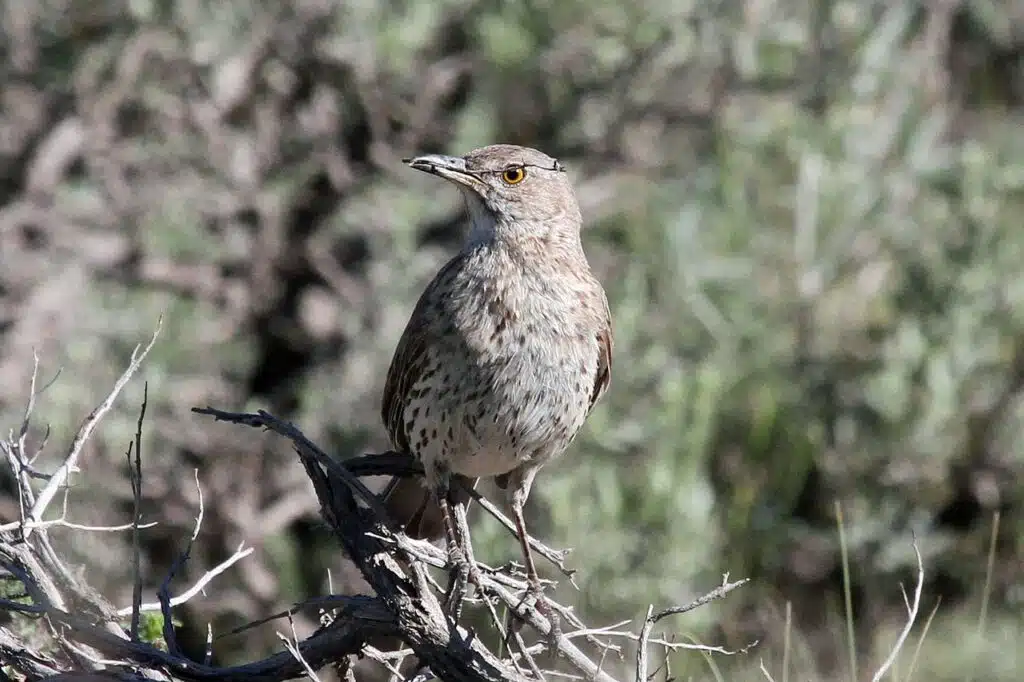
Bright yellow eyes are specific to this small bird. Sage Thrashers (Oreoscoptes montanus) grow to a minimum size of 7 inches with some of the largest individuals of the species reaching a size of 9 inches.
Bright yellow irises are characteristic of these types of birds.
As its name implies, the species is found in areas with sagebrush.
Some of the most important aspects of its habitat include the presence of sagebrush, a species that may sometimes be impacted by wildfire.
A North American native, Sage Thrashers are also known for having distinct warble-like noises.
Distribution – Southwestern United States, Mexico
20. Long-billed Thrasher
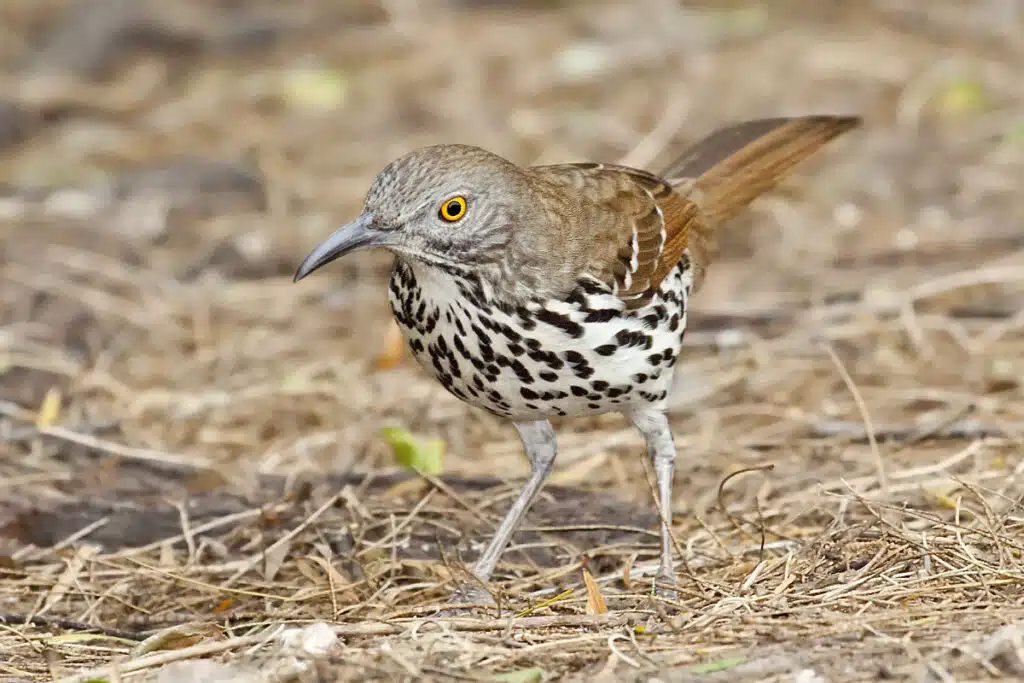
Sometimes confused with Sage Thrashers, Long-billed Thrashers (Toxostoma longirostre) have slightly distinct plumage and a different habitat.
They are Mexican natives and also feature bright yellow eyes.
Birds of this species are also known for having gray and brown heads, brown wings, and a white underbelly with distinct black spots.
Much of their lives are spent either hiding or looking for prey, typically on the ground. Long-billed Thrashers prefer insects.
Distribution – Mexico, Southwestern United States
21. At least Grebe
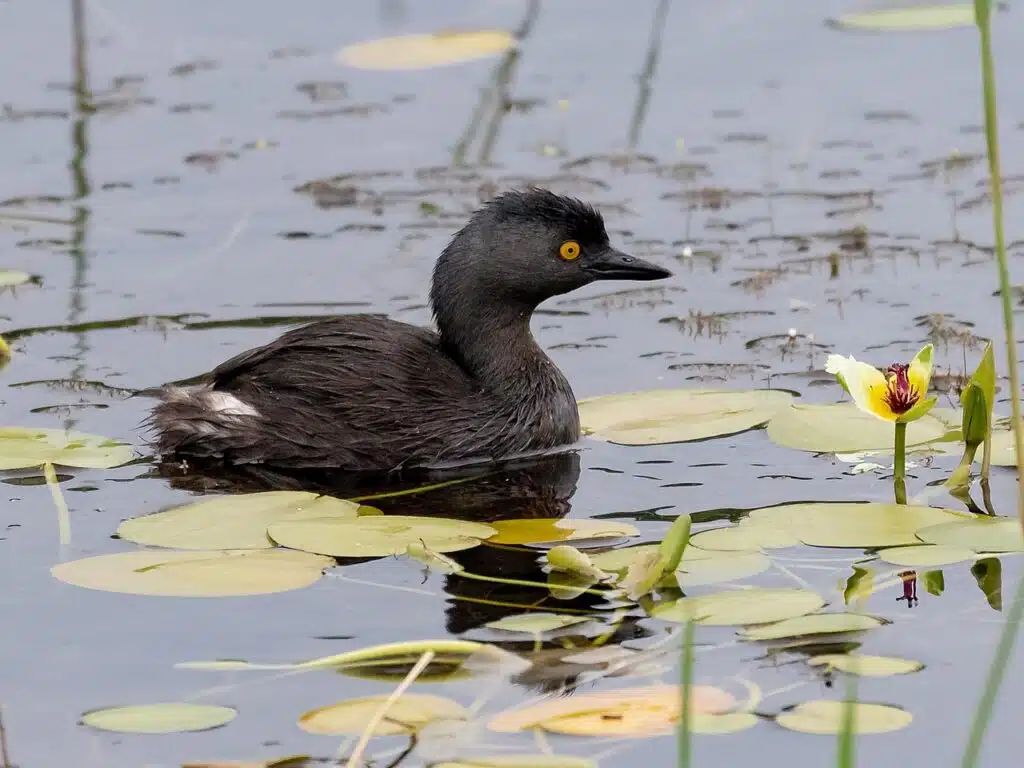
Least Grebes (Tachybaptus dominicus) are aquatic birds of Central and South America. Dominated by a gray appearance, these types of birds show dark gray heads and bright yellow eyes.
Their eyes stand out due to their dark plumage and their dark beaks.
Feeding on aquatic wildlife, these types of birds mostly feed on fish and crustaceans.
They are further known for having a distinct call that resembles a whining noise. Breeding throughout the year, these birds have also expanded their habitat to Texas.
Distribution – Central America, South America
22. Northern Saw-whet Owl
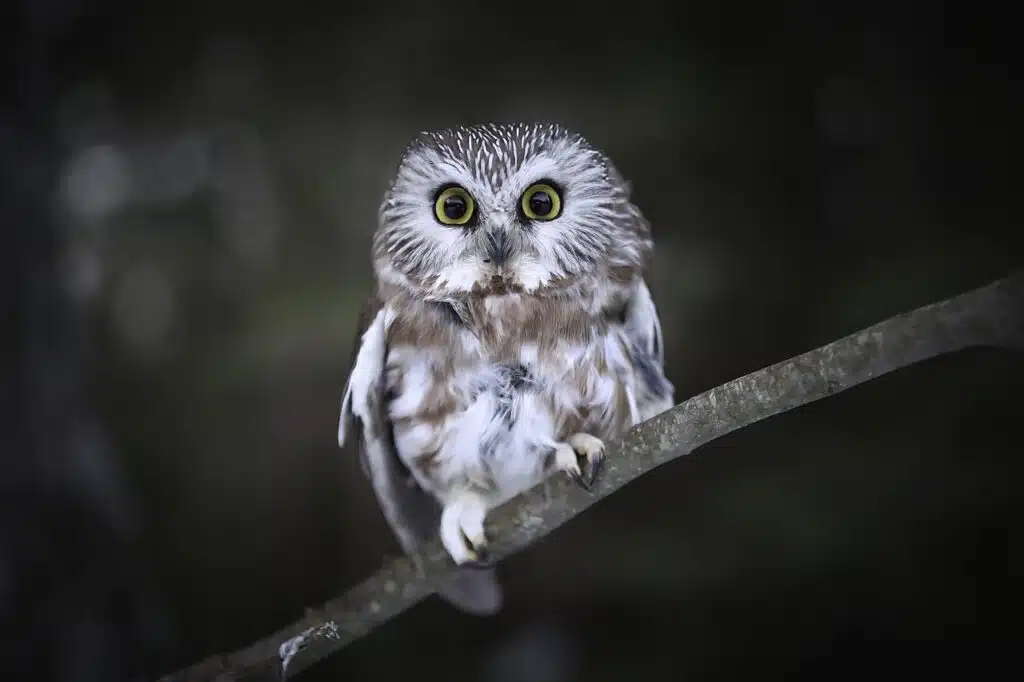
Large yellow eyes are specific to The Northern Saw-whet Owl (Aegolius acadicus).
A small species growing to an average of 7-8 inches, these owls have a brown appearance and cream body with a brown head as juveniles.
Found in coniferous and mixed woodlands, these owls are nocturnal and dependent on sound to locate prey.
They have differently-sized ears as they are adapted to detecting the faintest sounds to help them locate prey.
Distribution – United States, Canada
23. Yellow-eyed Junco
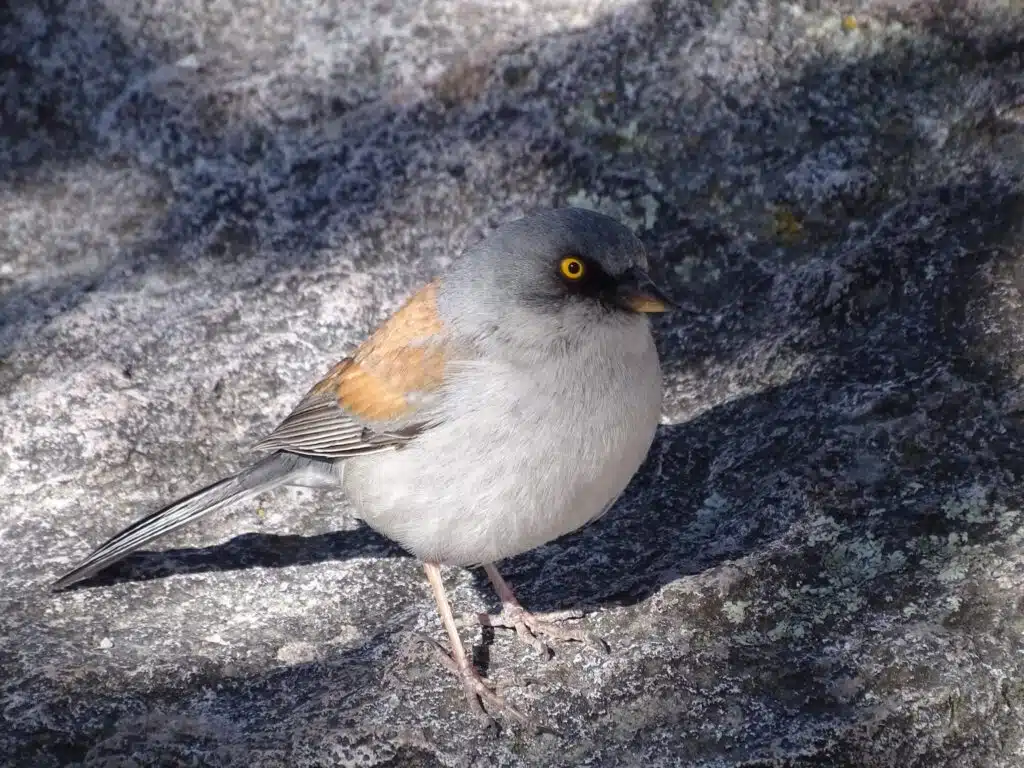
Yellow-eyed Juncos (Junco phaeonotus) are Mexican and US native gray birds with yellow eyes.
This species shows bright yellow eyes and a partially yellow beak. Its head is dark gray while its underbelly is bright grey.
A species found in Mexico, The Yellow-eyed Junco is also found in Southern Texas and the Southern territories of Arizona.
Distribution – Mexico, Texas, Arizona
24. Northern Hawk Owl
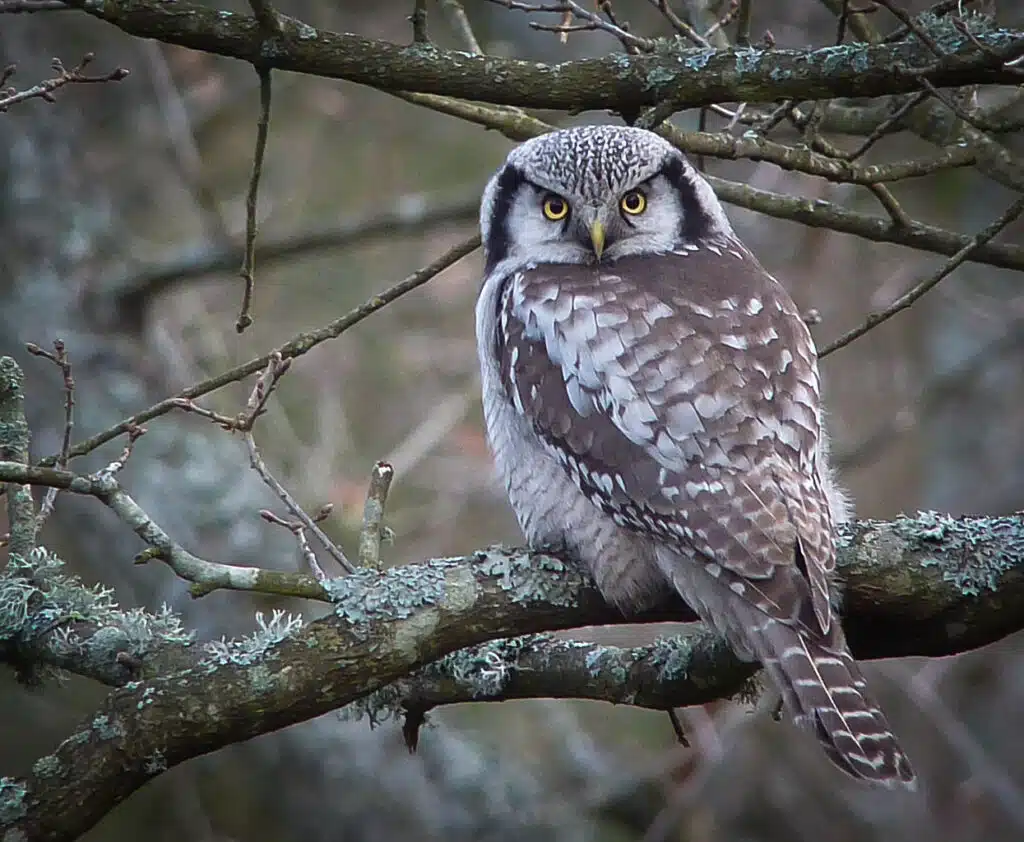
Yellow eyes and a matching beak color are specific to the mostly white Northern Hawk Owl (Surnia ulula).
This species is named after its Northern habitat as it lives in the upper part of The Northern Hemisphere.
Owls of this genus are very good predators, mainly catching rodents and small mammals. They are even used similarly to trained hawks.
Distribution – Canada, Alaska, Northern Europe, Northern Russia
25. Northern Goshawk
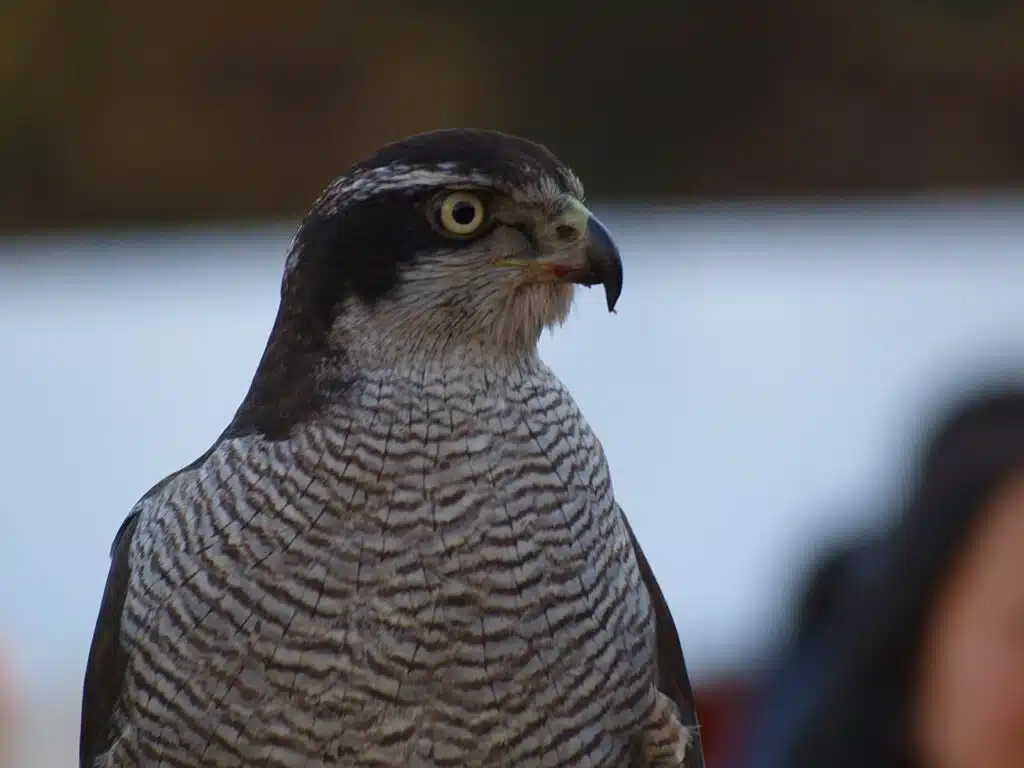
Yellow-orange eyes are specific to The Northern Goshawk (Accipiter gentilis). A species found around the world, this type of hawk grows to pale gray and white plumage.
It has a gray and white head where its crest is dark gray. The areas of its face behind its eyes are black.
Found in coniferous and mixed woodlands, Northern Goshawks are avid predators. They feed on large prey such as rabbits.
Distribution – North America, Europe, Asia
26. Elf Owl
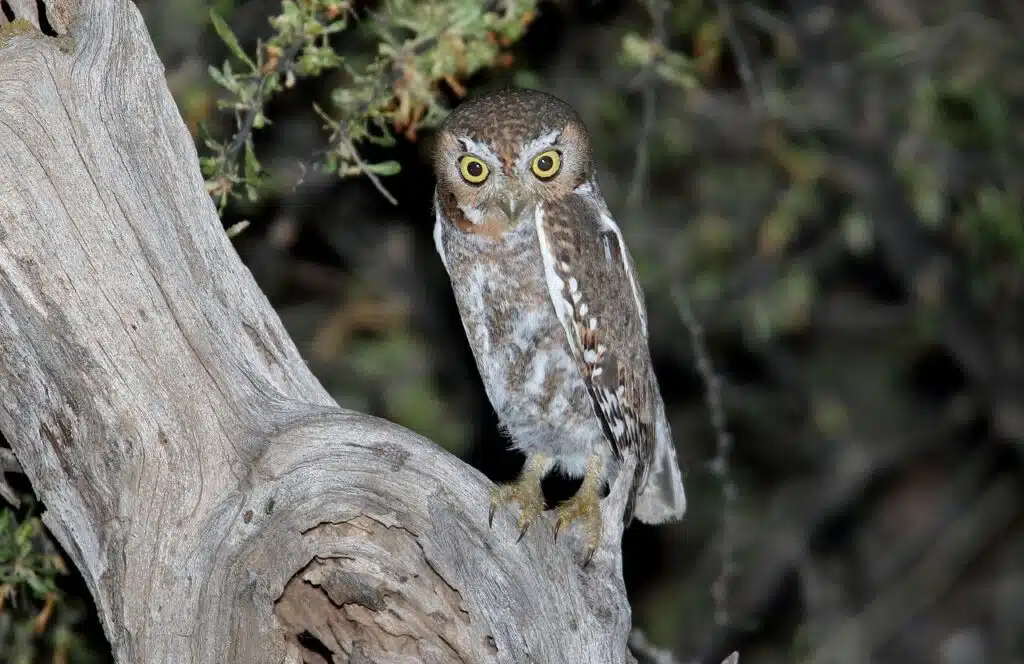
There are 4 subspecies of Elf Owl (Micrathene whitneyi) in the Southern and Southwestern US territories.
Owls of this species have large yellow eyes and live in states such as Texas and Arizona.
Elf Owls also live in California’s chaparral but they aren’t easily spotted as they’re mostly active at dusk, similar to many other species of owls.
While they live in the Southern states, Elf Owls migrate to Mexico to overwinter.
Distribution – California, Arizona, Texas, Baja California, Mexico
27. Masked Booby
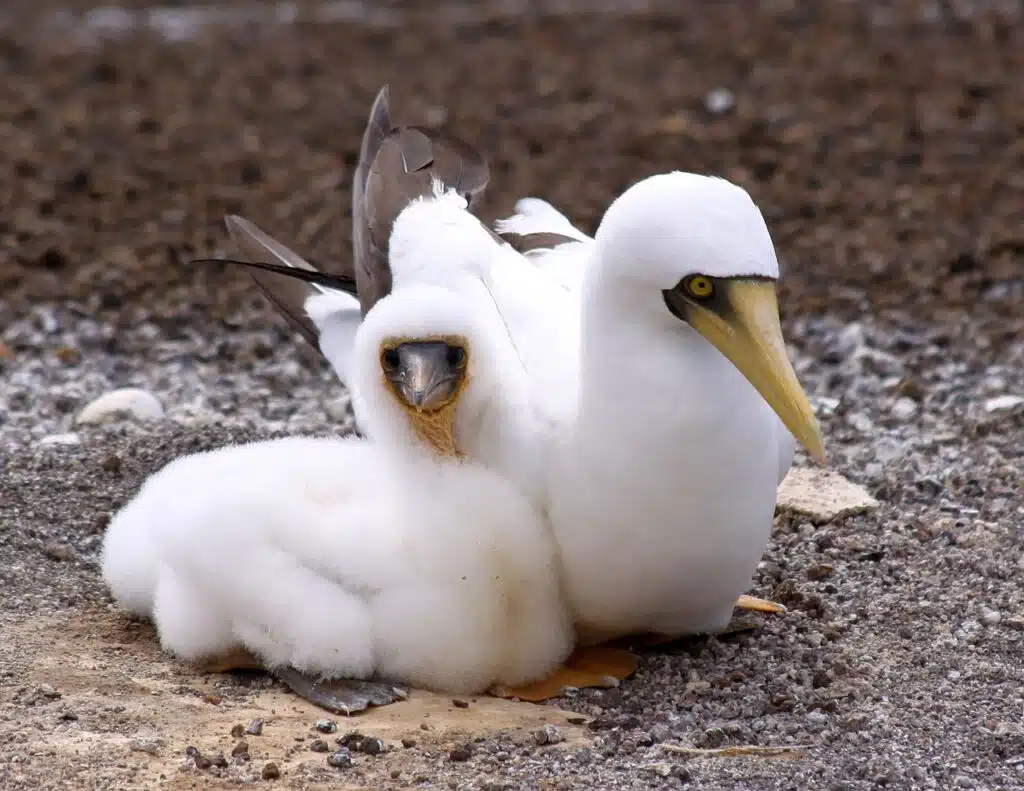
Yellow colors are important for the Masked Booby (Sula dactylatra) subspecies. This bird comes with yellow irises across its subspecies.
A long yellow bill and either yellow or orange legs are specific to this species.
Masker Booby are mostly black and white and they are easier to spot than other species as they live in colonies.
It breeds in remote areas of the oceans as it has a widespread habitat across tropical areas.
Distribution – The Atlantic Ocean, The Pacific Ocean
28. Whiskered Screech-Owl
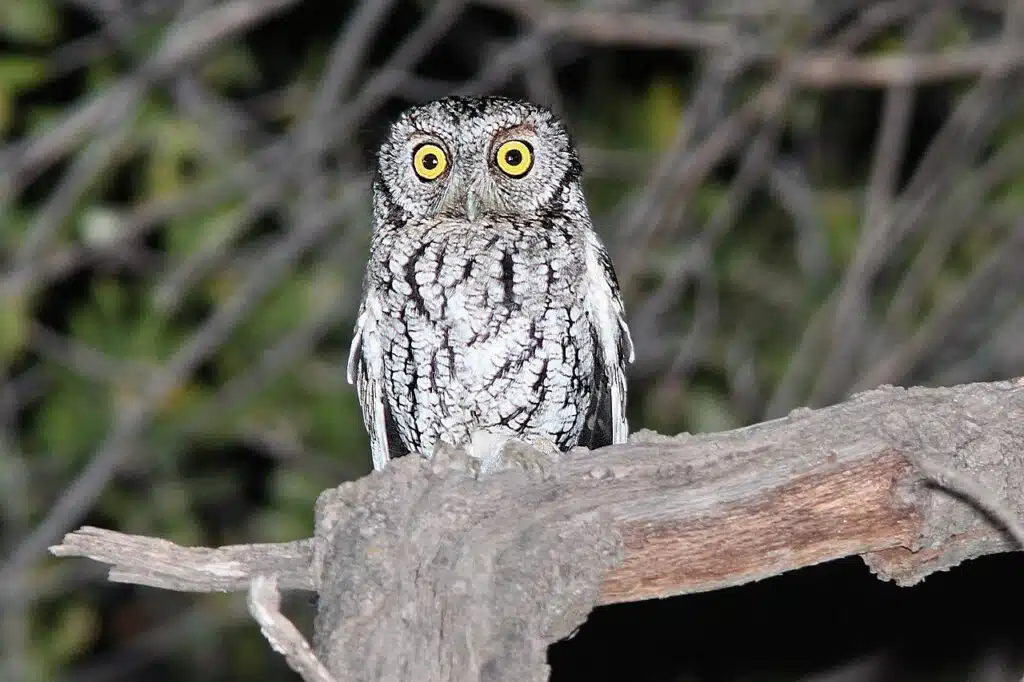
Brown, dark brown, and white plumage are characteristic of The Whiskered Screedch-Owl (Megascops trichopsis).
This is a species that has bright yellow eyes and which is also found in The United States. It lives in the Southern Regions of Arizona.
Specific to woodlands, Whiskered Screech-Owl is known for its short and repetitive sounds.
Growing up to a size of 7.9 inches, the small own uses old holes and cavities as its nests. It can repurpose woodpeckers nesting sites as its nests.
The 3 subspecies of Whiskered Screech-Owls always build their nests on trees, at a considerable height above the ground.
Cavities are their nests and they place small clusters of eggs here. They also hide and look for prey from these old tree cavities.
Distribution – Southern Arizona, Central Mexico, Guatemala, Nicaragua
29. Ferruginous Pygmy-Owl
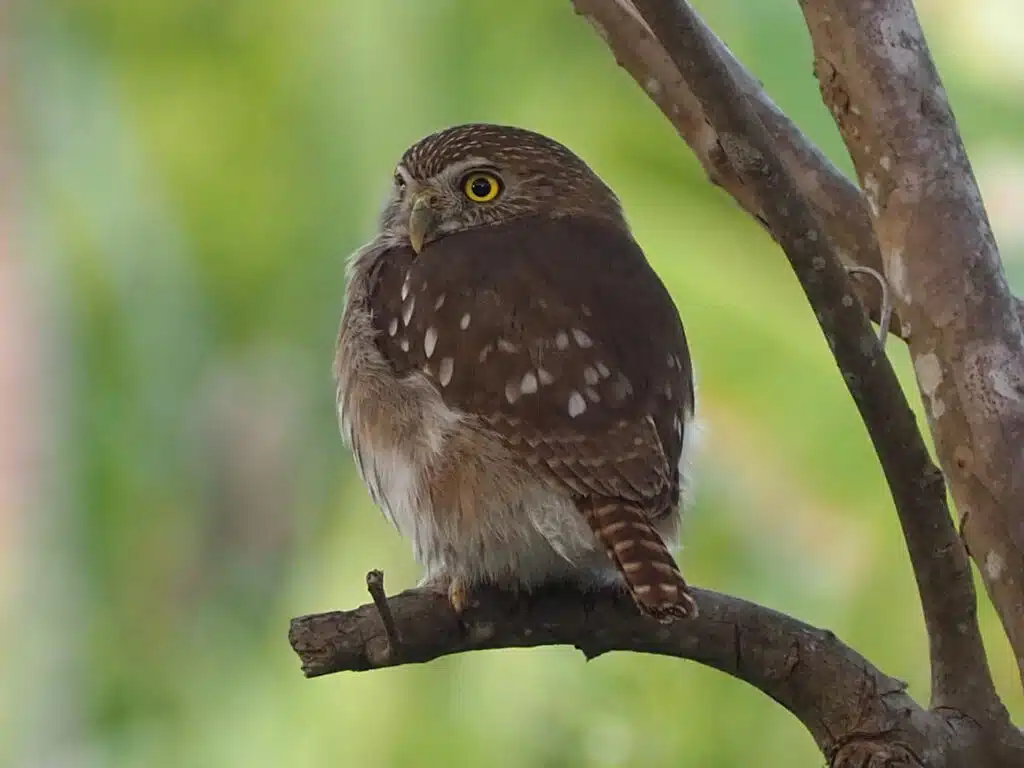
Light brown colors and brown streaks dominate the appearance of The Ferruginous Pygmy-Owl (Glaucidium brasilianum).
Tropical woodlands and pine woodlands are their most common habitats.
This yellow-eyed owl is also found in gray morphs across its habitat which spreads from North to South America.
Unlike the repetitive ticking sounds of Whiskered Screech-Owls, Ferruginous Pygmy-Owls have a repetitive whistling-like call.
As its name suggests, this type of owl is one of the smallest owls in the world. It may only reach a maximum length of 5.9 inches.
Despite being short, this owl is robust with a wide body and large feet.
Distribution – Arizona, Central America, South America
30. Osprey
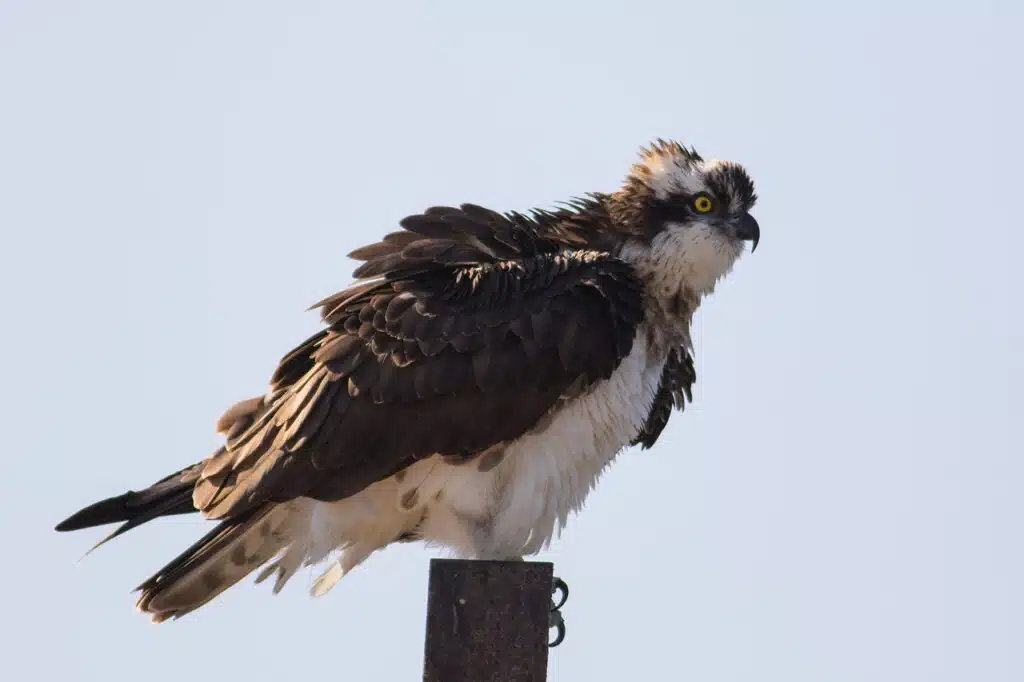
Yellow eyes are specific to Ospreys (Pandion haliaetus), a species of hawks found around the world.
This species is mostly found around rivers and water sources. It is even nicknamed The River Hawk as it rarely ventures away from water.
Its diet is the main reason for its presence next to rivers as Ospreys feed on fish.
Raptors or birds of prey are generally good at catching small prey. However, Ospreys are also very good at spreading out their habitat for food.
These birds are known as very good divers. While they don’t catch fish every time they dive, they still manage to have a very high success diving rate catching at least 1 fish for every 5 dives.
They represent one of the most common predatory birds in the world.
Manmade structures are some of the best places to find these birds. They tend to build nests on high vantage points such as on buildings, poles, or towers.
Distribution – throughout the world (except Antarctica)
31. Steller’s Sea-Eagle
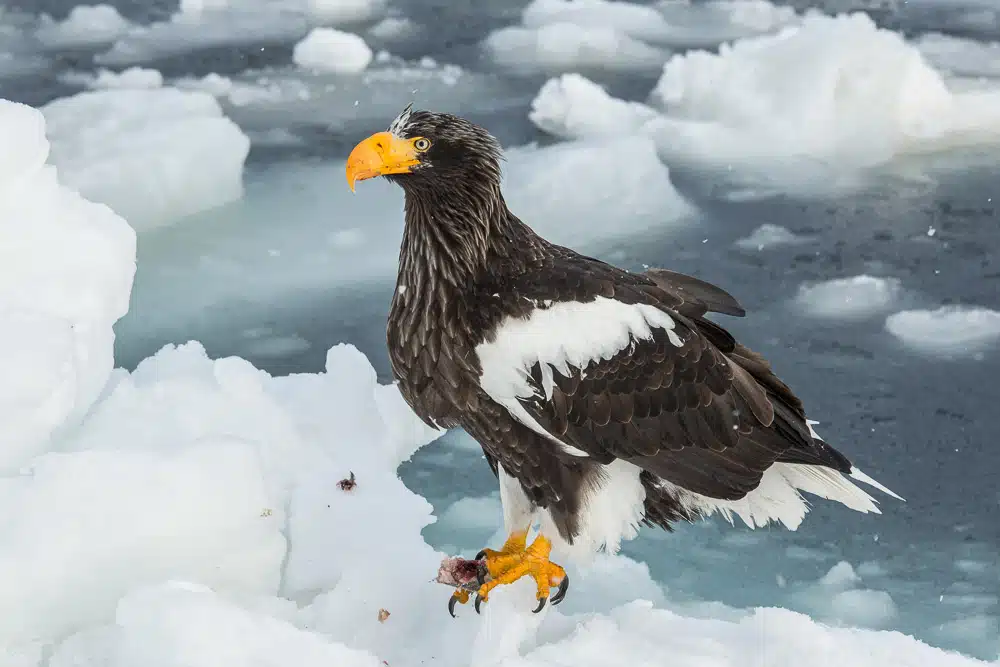
Yellow eyes, yellow skin sections around the eyes, and a yellow beak are specific to Steller’s Sea-Eagle (Haliaeetus pelagicus).
This is even a species that has vivid yellow legs.
With a wingspan of over 8 feet, this eagle is one of the largest in Asia and around the world.
Dark brown and white, Steller’s Sea-Eagle looks for fish in open waters. It prefers fish such as pink and chum salmon.
It can even eat large birds it shares its habitat with such as seagulls.
These birds have secretive breeding habits. They build nests themselves but always place them in areas that are hard to reach.
From trees to open cliff edges, Steller’s Sea-Eagle nests may only house a single egg per breeding period.
Distribution – China, Japan, North Korea, South Korea, East Russia